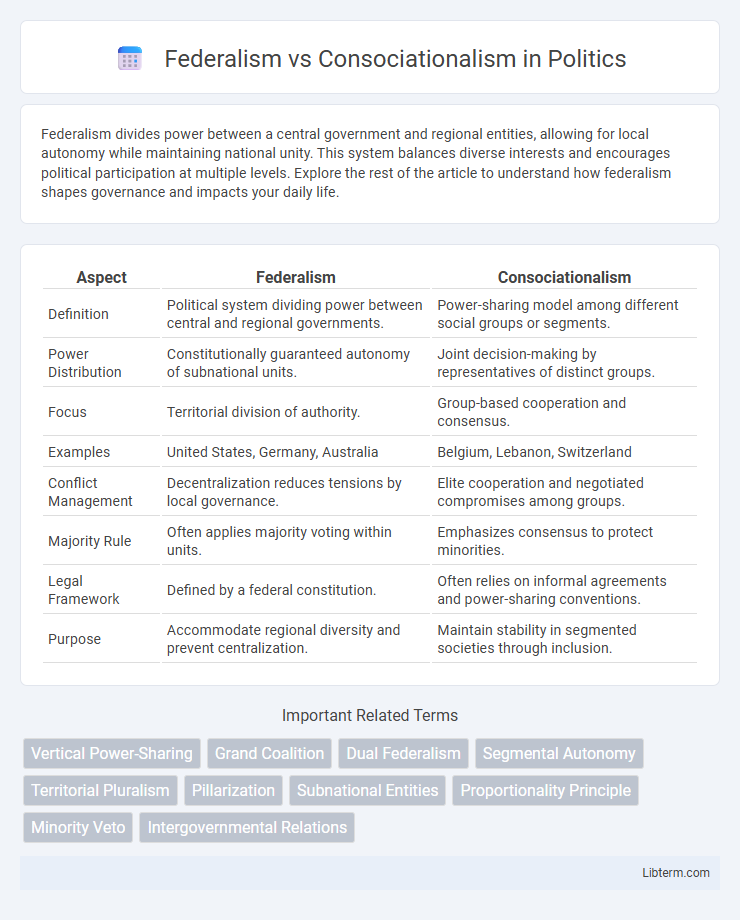Federalism divides power between a central government and regional entities, allowing for local autonomy while maintaining national unity. This system balances diverse interests and encourages political participation at multiple levels. Explore the rest of the article to understand how federalism shapes governance and impacts your daily life.
Table of Comparison
| Aspect | Federalism | Consociationalism |
|---|---|---|
| Definition | Political system dividing power between central and regional governments. | Power-sharing model among different social groups or segments. |
| Power Distribution | Constitutionally guaranteed autonomy of subnational units. | Joint decision-making by representatives of distinct groups. |
| Focus | Territorial division of authority. | Group-based cooperation and consensus. |
| Examples | United States, Germany, Australia | Belgium, Lebanon, Switzerland |
| Conflict Management | Decentralization reduces tensions by local governance. | Elite cooperation and negotiated compromises among groups. |
| Majority Rule | Often applies majority voting within units. | Emphasizes consensus to protect minorities. |
| Legal Framework | Defined by a federal constitution. | Often relies on informal agreements and power-sharing conventions. |
| Purpose | Accommodate regional diversity and prevent centralization. | Maintain stability in segmented societies through inclusion. |
Introduction to Federalism and Consociationalism
Federalism is a political system where power is constitutionally divided between a central government and subnational units, allowing regional autonomy and shared sovereignty. Consociationalism is a governance model designed for divided societies, emphasizing power-sharing, group autonomy, and elite cooperation to maintain stability and representation of diverse social segments. Both frameworks address governance in pluralistic states but differ fundamentally in power distribution and mechanisms for managing social diversity.
Defining Federalism: Key Principles and Structures
Federalism is a political system characterized by the division of power between a central government and constituent political units, such as states or provinces, allowing for shared governance and regional autonomy. Key principles include constitutionally guaranteed self-rule, a written constitution outlining the distribution of powers, and a bicameral legislature representing both the population and the constituent units. Federal structures promote the balancing of unity and diversity by enabling localized decision-making while maintaining national cohesion.
Understanding Consociationalism: Core Concepts
Consociationalism is a power-sharing political framework designed to manage deeply divided societies through elite cooperation and group autonomy, ensuring stability and representation for distinct social groups. It emphasizes grand coalitions, mutual veto rights, proportionality in political representation, and segmental autonomy, allowing each group to maintain its identity while participating in governance. Unlike federalism, which divides power territorially, consociationalism relies on negotiated agreements among social groups to foster consensus and prevent conflict.
Historical Contexts: Origins and Evolution
Federalism originated in the 18th century as a response to the need for uniting diverse colonies under a single constitution, exemplified by the formation of the United States in 1787, promoting shared sovereignty between central and regional governments. Consociationalism emerged in the 20th century, particularly post-World War II, as a mechanism to manage deep ethnic, religious, or linguistic divisions within states like Belgium and the Netherlands, emphasizing power-sharing among elite groups to maintain stability. Both systems evolved to address different historical challenges of governance, with federalism focusing on regional autonomy within a unified state and consociationalism on collaborative governance among segmented societies.
Power Distribution: Vertical vs. Horizontal Approaches
Federalism emphasizes vertical power distribution by allocating authority between central and subnational governments, enabling regional autonomy within a unified state. Consociationalism focuses on horizontal power-sharing among distinct ethnic, religious, or linguistic groups to maintain political stability through inclusive decision-making. While federalism structures power territorially, consociationalism ensures group representation and cooperation across societal divisions.
Conflict Management in Divided Societies
Federalism structures political power by dividing authority between central and regional governments, enabling ethnic or cultural groups to exercise self-governance and reduce intergroup tensions in divided societies. Consociationalism manages conflict through power-sharing arrangements among elites from different segments, promoting cooperation, mutual vetoes, and proportional representation to ensure minority protection. While federalism institutionalizes territorial autonomy, consociationalism emphasizes political collaboration across diverse communities to stabilize conflict-prone environments.
Case Studies: Federal vs. Consociational Systems
Federalism in countries like the United States and Germany emphasizes division of power across regional governments, promoting autonomy while maintaining national unity. In contrast, consociational systems found in Belgium and Lebanon prioritize power-sharing among distinct ethnic or religious groups to ensure political stability and minority protection. Case studies reveal federalism's strength in managing territorial diversity, whereas consociationalism excels in accommodating segmented societies with deep social cleavages.
Strengths and Weaknesses of Each Model
Federalism offers strong decentralization, allowing regional governments autonomy to manage local affairs, which can enhance democratic participation and reduce ethnic tensions by recognizing distinct group identities. Its weaknesses include potential inefficiencies from overlapping jurisdictions and the risk of regional disparities in resource distribution, which may exacerbate inequalities. Consociationalism promotes political stability through power-sharing and elite cooperation among diverse groups, ensuring minority protection and fostering social cohesion; however, it can entrench divisions by institutionalizing group identities and may suffer from elite deadlock or slow decision-making processes.
Selecting a System: Factors Influencing Choice
Selecting a system between federalism and consociationalism depends on factors such as ethnic diversity, historical conflict, and political stability. Federalism suits regions with clear territorial divisions and seeks to allocate power across autonomous units, while consociationalism is preferred in deeply divided societies requiring power-sharing mechanisms among distinct groups. The choice hinges on the ability of institutions to manage social cleavages and maintain inclusive governance.
Future Trends: Federalism and Consociationalism in a Changing World
Federalism and consociationalism are evolving to address increasing global diversity and complex governance challenges, with federal systems emphasizing decentralized authority to accommodate regional autonomy while consociational models prioritize power-sharing among distinct social groups. Future trends indicate enhanced hybridity, where federal frameworks incorporate consociational mechanisms to manage multicultural societies and prevent conflict. Innovations in digital governance and transnational cooperation further influence these systems, promoting adaptive, inclusive political structures responsive to dynamic demographic and sociopolitical landscapes.
Federalism Infographic

 libterm.com
libterm.com